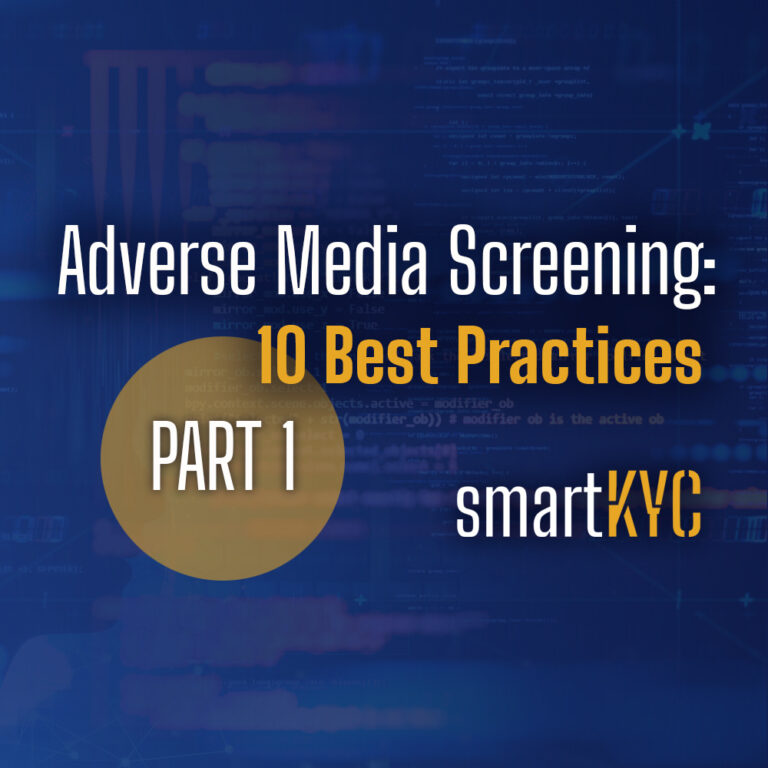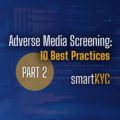When sifting through prohibitive capital costs, the increase in operating expenditures, and the possibility of alternative monitoring scenarios, many are daunted when considering implementing a continuous adverse media screening programme.
Despite the challenges, we see an increased awareness in banks to stay ahead of regulators by implementing high frequency adverse media screening programmes. Learn how to better implement a continuous or high frequency negative news screening programme with smartKYC’s series of 10 top tips to consider. Take a look at our first three tips in this article.
1. Decide what you want to monitor
You cannot monitor everything. While it is possible to look for changes gathered at the onboarding stage, there should be a framework for what is going to give your business insight.
Banks should develop a framework for what KYC looks like for each of these three activities:
– Country or sector exposure
– Environmental, social and governance (ESG) breaches
– Source of wealth development
By planning for monitoring these areas, material can be sifted out and then later picked up at the next routine refresh cycle.
Now, it may be helpful to go a step further. Rather than screening for all risks, focus your high frequency adverse media screening on new, adverse legal reporting only.
It is important to define negative news screening to avoid overload. This can help your system become highly granular and nuanced to distinguish between legal matters. For example, your system should be able to understand the context of complicated words such as ‘accusation.’ There is a difference in an accusation from the International Criminal Court and being accused of infidelity.
Your system should be making these distinctions for you.
2. The inconvenience of languages
Monitoring English language content alone will expose international banks to the risk of missing important intelligence. Extracting intelligence from foreign language is a must in adverse media screening, and it is imperative to have reliable translations.
Some software may produce machine-translated non – English material first and then derive results based on the translation. Not only will this material lose the nuances of the language, but will potentially loss of original meaning. This can have serious implications, which can be seen below.

- A Google translation of this Arabic sentence is: “The interests of the gendarmerie were achieved with Asaad Rabrab.”
- What it really means is: “The gendarmerie investigates Issad Rebrab.” The key term ‘investigate’ is lost and a potential risk is not flagged up
黎明从未成年起就抢劫伤人,二进宫以后仍然不悔改
- Similarly, this Simplified Chinese excerpt is machine translated as: “Dawn has never robbed and wounded people since he was an adult.”
- Whereas in English it means: “Li Ming has started robbing and hurting people since he was a juvenile, and never repented after he was re-incarcerated.”
It’s not just non-Latin languages where these mistakes can be found. Problems can arise closer to home.
“Attaqué en diffamation par Cédric Herrou, Eric Ciotti relaxé”
- Machine translates as: “Defamed by Cédric Herrou, Eric Ciotti released.”
- But the actual meaning is the opposite: “Accused of defamation by Cédric Herrou, Eric Ciotti is released.”
Minor mistakes could have major consequences. Stripping away the syntactical, grammatical, and lexical rules of the original language for the sake of the ‘convenience’ of processing everything in English will prove an expensive shortcut.
Ensure that you have a system that is reliable in this area.
3. Managing content costs
Access to a complete news archive of premium licensed materials is wholly unnecessary. A common fear we see is that the content cost of searching many thousands of client names via premium media sources will prove prohibitive.
The truth is that content providers have solutions better suited to monitoring the last 24-hour news cycle only, which are both cost-effective (i.e. predominantly unlicensed and at an unmetered price tag) and of excellent quality.
Rather than monitoring in the typical above inside-out approach (i.e. these are my client names, searching every day/ hour) we recommend to search in the opposite order.
This process, also known as an outside-in approach, processes the last 24—hour news cycle for adverse references, and extracts the actors from the articles then serves this as a feed to the bank. Therefore, rather than matching the bank’s client names there can either be a manual process or sophisticated name matching tools can be used.
This process will help save costs and eliminate the need for constant monitoring in adverse media screening.
Defining your negative news screening, having reliable translations and taking an outside-in approach are our first 3 tips for a robust and thorough adverse media screening programme. Later in the series we will take a look at 7 more factors to consider.
Click to read the next article in this series: Adverse Media Screening: 10 Best Practices – Part 2.
About smartKYC
smartKYC is the world’s most advanced multilingual semantic search engine to machine read all online media content for potential adverse news about your clients, improving KYC processes and reducing risks.
The shortcomings of traditional adverse media screening tools result in inefficiency, frustration and a lack of confidence in the work done. In contrast, smartKYC’s semantic search and media analysis platform results in faster, better and more cost-effective KYC.
If you’re interested in learning more about smartKYC’s smartLIST technology and how it can transform the efficiency and effectiveness of your KYC operations, contact us today.

